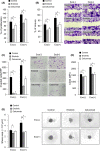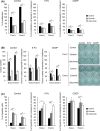Epidermal growth factor/epidermal growth factor receptor signaling blockage inhibits tumor cell-derived exosome uptake by oral squamous cell carcinoma through macropinocytosis
- PMID: 34874595
- PMCID: PMC8819298
- DOI: 10.1111/cas.15225
Epidermal growth factor/epidermal growth factor receptor signaling blockage inhibits tumor cell-derived exosome uptake by oral squamous cell carcinoma through macropinocytosis
Abstract
Various cell types secrete exosomes into their surrounding extracellular space, which consequently affect the function and activity of recipient cells. Numerous studies have showed that tumor cell-derived exosomes play important roles in tumor growth and progression. Although a variety of endocytic pathways are reportedly involved in the cellular uptake of exosomes, detailed mechanisms remain unknown. The present study demonstrated that treatment with recombinant epidermal growth factor (EGF) time- and dose-dependently promoted cellular uptake of oral squamous cell carcinoma (OSCC) cell-derived exosomes into OSCC cells themselves. Conversely, EGF receptor (EGFR) knockdown and treatment with EGFR inhibitors, including erlotinib and cetuximab, abrogated OSCC cell uptake of exosomes. The macropinocytosis inhibitor 5-(N-ethyl-N-isopropyl) amiloride (EIPA) blocked the effects of active EGF/EGFR signaling on uptake of OSCC cell-derived exosomes. These EGFR inhibitors also suppressed OSCC cell-derived exosome-induced proliferation, migration, invasion, stemness, and chemoresistance of OSCC cells. Taken together, the data presented herein suggest that EGFR inhibitors might inhibit the malignant potential of OSCC cells through direct inhibition of not only EGFR downstream signaling pathway but also cellular uptake of OSCC cell-derived exosomes through macropinocytosis.
Keywords: EGF; EGFR; exosome; macropinocytosis; oral squamous cell carcinoma.
© 2021 The Authors. Cancer Science published by John Wiley & Sons Australia, Ltd on behalf of Japanese Cancer Association.
Figures







Similar articles
-
Carcinogenic epithelial-mesenchymal transition initiated by oral cancer exosomes is inhibited by anti-EGFR antibody cetuximab.Oral Oncol. 2018 Nov;86:251-257. doi: 10.1016/j.oraloncology.2018.09.030. Epub 2018 Oct 5. Oral Oncol. 2018. PMID: 30409309
-
Application of a Persistent Heparin Treatment Inhibits the Malignant Potential of Oral Squamous Carcinoma Cells Induced by Tumor Cell-Derived Exosomes.PLoS One. 2016 Feb 5;11(2):e0148454. doi: 10.1371/journal.pone.0148454. eCollection 2016. PLoS One. 2016. PMID: 26849680 Free PMC article.
-
Anti-EGFR antibody cetuximab is secreted by oral squamous cell carcinoma and alters EGF-driven mesenchymal transition.Biochem Biophys Res Commun. 2018 Sep 10;503(3):1267-1272. doi: 10.1016/j.bbrc.2018.07.035. Epub 2018 Jul 13. Biochem Biophys Res Commun. 2018. PMID: 30017201
-
Epidermal growth factor receptor (EGFR) and squamous cell carcinoma of the skin: molecular bases for EGFR-targeted therapy.Pathol Res Pract. 2011 Jun 15;207(6):337-42. doi: 10.1016/j.prp.2011.03.002. Epub 2011 Apr 29. Pathol Res Pract. 2011. PMID: 21531084 Review.
-
Tiny messengers, big Impact: Exosomes driving EMT in oral cancer.Pathol Res Pract. 2025 Apr;268:155873. doi: 10.1016/j.prp.2025.155873. Epub 2025 Feb 27. Pathol Res Pract. 2025. PMID: 40022766 Review.
Cited by
-
Lung Fibroblasts Take up Breast Cancer Cell-derived Extracellular Vesicles Partially Through MEK2-dependent Macropinocytosis.Cancer Res Commun. 2024 Jan 22;4(1):170-181. doi: 10.1158/2767-9764.CRC-23-0316. Cancer Res Commun. 2024. PMID: 38259097 Free PMC article.
-
Exosomes in Oral Diseases: Mechanisms and Therapeutic Applications.Drug Des Devel Ther. 2025 Jan 22;19:457-469. doi: 10.2147/DDDT.S505355. eCollection 2025. Drug Des Devel Ther. 2025. PMID: 39867866 Free PMC article. Review.
-
Cetuximab modifies the release and protein content of tumor microvesicles from head and neck squamous cell carcinoma cells: What are the consequences on endothelial cells?J Cell Commun Signal. 2025 Aug 4;19(3):e70026. doi: 10.1002/ccs3.70026. eCollection 2025 Sep. J Cell Commun Signal. 2025. PMID: 40766966 Free PMC article.
-
The interplay between the tumor microenvironment and tumor-derived small extracellular vesicles in cancer development and therapeutic response.Cancer Biol Ther. 2024 Dec 31;25(1):2356831. doi: 10.1080/15384047.2024.2356831. Epub 2024 May 20. Cancer Biol Ther. 2024. PMID: 38767879 Free PMC article. Review.
-
The Roles of Exosomes in the Diagnose, Development and Therapeutic Resistance of Oral Squamous Cell Carcinoma.Int J Mol Sci. 2023 Jan 19;24(3):1968. doi: 10.3390/ijms24031968. Int J Mol Sci. 2023. PMID: 36768288 Free PMC article. Review.
References
-
- Bray F, Ferlay J, Soerjomataram I, Siegel RL, Torre LA, Jemal A. Global cancer statistics 2018: GLOBOCAN estimates of incidence and mortality worldwide for 36 cancers in 185 countries. CA Cancer J Clin. 2018;68:394‐424. - PubMed
-
- Okura M, Aikawa T, Sawai NY, Iida S, Kogo M. Decision analysis and treatment threshold in a management for the N0 neck of the oral cavity carcinoma. Oral Oncol. 2009;45:908‐911. - PubMed
-
- da Silva SD, Ferlito A, Takes RP, et al. Advances and applications of oral cancer basic research. Oral Oncol. 2011;47:783‐791. - PubMed
-
- Mathivanan S, Ji H, Simpson RJ. Exosomes: extra‐cellular organelles important in intercellular communication. J Proteomics. 2010;73:1907‐1920. - PubMed
MeSH terms
Substances
Grants and funding
LinkOut - more resources
Full Text Sources
Medical
Research Materials
Miscellaneous

